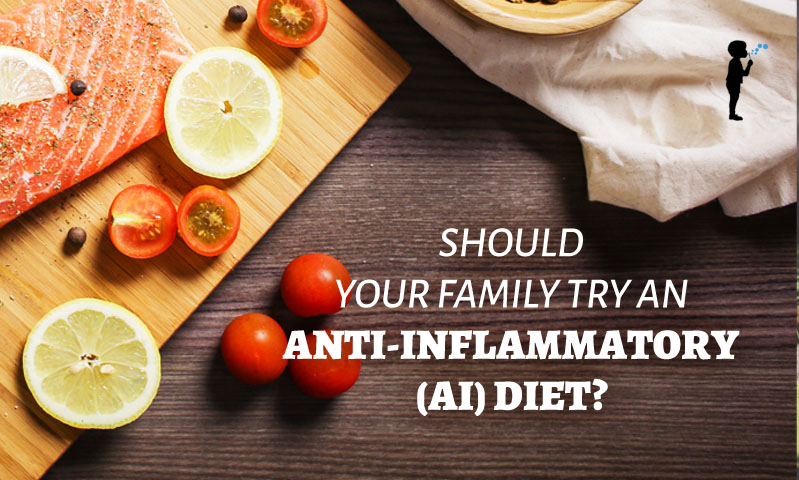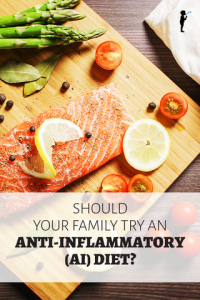
Should your family try an anti-inflammatory (AI) diet?
[pro_ad_display_adzone id=”11973″ corner_curl=”1″ corner_small=” 26″ corner_big=”120″ corner_animate=”1″]
While gluten-free and casein-free (dairy-free) are terms that many people are now familiar with, it is not always clear why and when to avoid these foods and even if just these two are enough. The anti-inflammatory (AI) diet (and there are many versions of this) is not just one thing, but really a spectrum of dietary guidelines where the severity of symptoms helps determine how many foods to avoid. The basic AI diet avoids gluten, dairy, soy, corn, alcohol and sugar. More comprehensive versions also eliminate eggs, red meat, peanuts and nightshade vegetables (potatoes, tomatoes, eggplant and peppers). And the most restrictive version is called the Autoimmune Protocol (AIP) diet, which also avoids nuts and legumes. (For more information on How To Do an Elimination/Challenge Diet, check out our e-book!)
“Oh my gosh, what on earth am I going to eat?!” is a common response I hear in my office when I recommend the AI diet. So, let’s back up a moment.
Why do an AI Diet?
The primary goal of an AI diet is exactly what it sounds like: to reduce chronic inflammation. This sounds very generic, but in essence, most chronic diseases originate from high amounts of chronic inflammation (1). Chronic inflammation can occur in any tissue and any organ system and can play a role in almost any disease process.
These can include:
- Asthma, Allergies and Eczema (called the Atopic Triad)
- Autoimmune disease such as Rheumatoid Arthritis, Hashimoto’s Thyroiditis, Crohn’s and Ulcerative Colitis
- Digestive complaints such as IBS, multiple food sensitivities or unknown gas and bloating
- Behavioral and developmental disorders such as Autism, Sensory Processing Disorder, and ADD/ADHD
- As a part of a weight loss and detoxification program
- And to treat chronic symptoms with no known cause
What is chronic inflammation?
Inflammation is the body’s protective response against injury (damaged cells), invasion (microbial infection) and toxicity. This necessary process is important to survival but, like in any war, can harm innocent bystanders (our own tissues). Chronic inflammation can happen when the immune system is activated towards a stimulus that does not go away, when the immune system turns on its own body, and when an acute (short-term) problem does not completely resolve. (2)
How does an AI Diet help decrease chronic inflammation?
It is not always clear (in fact, rarely) what is the trigger or driving force causing chronic inflammation. As practitioners and patients, we have to be detectives to find the source(s) of the inflammation. Some common sources, like environmental toxicity and emotional responses, are harder to detect, treat and control. We have near complete control over the food we put in our bodies and so this is an easier, and often more impactful, place to start. Don’t misunderstand; I’m not saying it’s easy. But it’s doable. And since food and our gastrointestinal (GI) function are so essential to all health and disease (3), following an AI diet can often bring about noticeable change in a relatively fast period of time.
The goal of the AI diet is to reduce inflammation through avoiding the most common causes of food sensitivity. The most common food allergens (and the top 8 that are responsible for anaphylaxis) (4) are:
- Milk
- Eggs
- Fish
- Crustacean shellfish
- Tree nuts (e.g., almonds, walnuts, pecans)
- Peanuts
- Wheat
- Soybeans
Furthermore, the AI diet eliminates other foods that may cause inflammation through other means (such as having an excess of Omega-6 Fatty Acids or causing high levels of metabolic waste). While fish and shellfish can be a cause of anaphylaxis reactions (e.g. facial swelling, difficulty breathing, severe hives), these are not typically inflammatory foods if a person is not outright allergic to them so they are not included in the AI diet.
Ok, so how on earth do I feed my family according to an AI diet?!?
It depends on your goals. Some people use an anti-inflammatory diet as an elimination challenge to determine specific food sensitivities. So, for these situations, you can usually use substitution products like coconut milk yogurt and gluten-free flour blends in order to continue eating certain key North American Diet staples like sandwiches and pancakes. An Elimination Diet is typically accomplished by following an AI diet for 4-6 weeks (which is the amount of time required in order for an antibody created in response to a food trigger to go away and the immune response to calm down), and then each food group is introduced one day at a time to see if any symptoms develop. The reintroduction period typically takes another two weeks, making it 8 weeks total for the diet.
For people using an AI diet as treatment of a chronic disease, you create a new normal. I always caution people against using too many processed “substitution” foods like gluten-free cookies and vegan cheese because these products may be loaded with fillers and gums that can also be a problem for people. What I mean by “create a new normal” is that slowly but surely, you find different go-to meals and snacks rather than similar variations of the same meal. For example, did you previously eat cereal with milk for breakfast? At the beginning, choosing a gluten-free cereal with almond milk might be a good substitute. But eventually, you want to start eating something else entirely like a green smoothie with avocado (5) or a traditional Japanese style breakfast (6), or protein-packed oatmeal with chia, nuts, coconut and fruit. This can be very hard at first, but gets progressively easier until it is just second nature. In fact, many of my patients report to me that after eating this way for a while they no longer enjoy the taste of previous “guilty pleasure” foods.
Some of my favorite blogs that are whole-food based with many gluten-free and dairy-free recipes are:
- http://minimalistbaker.com/
- http://yumuniverse.com/
- http://ohsheglows.com/
- http://drjessicablack.com/recipes/
- http://nomnompaleo.net/recipeindex/
And here are my top 12 tips from personal and professional experience:
- Add veggies to absolutely everything. For example:
- Eggs with chard and spinach
- Smoothies with greens
- Pasta sauce on a bed of spiralized sweet potato or zucchini
- Pesto with ½ basil and ½ kale
- Fill your plate with at least ½ veggies. Fruits are additional to a meal
- Be creative and do not be afraid to experiment (or have those experiments fail)
- ALWAYS read the ingredients
- Right away, find some go-to snacks for those hungry moments when nothing else is prepared
- Nuts and fruit
- Energy balls (I make a bunch and keep them in the freezer)
- Lara Bars or certain Kind bars (I have no affiliation)
- Dehydrated or freeze-dried fruits, veggies and jerky
- Bring your own cupcakes if going to a birthday party. Try these amazing Black bean flour-free chocolate cupcakes! My girls LOVE them and, again, I make a bunch and keep them in the freezer for special occasions
- Always bring a dish you can eat if going to a Pot Luck
- Talk to your kids and explain to them why you are choosing to eat this way. For example, “honey you know how your tummy always hurts? You can make your tummy feel better by changing the foods you eat!”
- Make it a game and something that makes your kid special. My daughter likes to proudly announce, “I’m Gluten-Free!” as she eats her very own special cupcake at the party.
- Don’t sweat it if you have a cheat day; just get back on the wagon again the next day.
- Know your style. Some people only succeed if they cut out everything at once cold turkey. Others need to ease in to it by starting with just avoiding gluten.
- It’s a process.
It took me 3 years to figure out how I personally responded to different foods and which were the main culprits for my symptoms (although I started feeling better immediately). You may go through half a dozen different rounds of elimination diets before you fine-tune what is your perfect diet for controlling or resolving inflammation-related symptoms. This process involves practical, physical and, most especially, the emotional aspects of eating and illness. It took one of my beer-loving patients a full year, from the day I told him I thought that gluten was a prime culprit in his asthma symptoms, till the day he told me, “I think it’s wheat,” and gave up drinking beer.
Work with an expert
There are many experts in nutrition and natural medicine and working with someone who has clinical and professional experience is a huge help. Most importantly, always talk with your physician first to make sure that doing an AI diet is right for you.
References and additional resources:
- https://www.cdc.gov/pcd/issues/2012/11_0301.htm
- http://www.britannica.com/science/inflammation
- http://www.hindawi.com/journals/jir/2014/689492/
- http://www.fda.gov/Food/ResourcesForYou/Consumers/ucm079311.htm
- http://www.huffingtonpost.com/2014/04/23/avocado-smoothies_n_5193023.html
- http://www.huffingtonpost.com.au/2016/06/05/is-traditional-japanese-breakfast-the-healthiest-way-to-start-yo/
- https://mealthy.com/cook-smarter/the-ultimate-guide-to-gluten-free-eating


